HISTORY
This center merges from Lukang branch station and Chupei branch station :
Lukang branch station:
- 1930Established in Japanese colonial era, under Taichung province the interior division.
- 1931Renamed Taichung provincial aquatic experiment station.
- 1945Renamed Taichung prefectural aquatic experiment station after the retrocession of Taiwan.
- 1947As the aquabranch station of Taichung prefectural agriculture-forestry farm.
- 1950Reorganized as the aquabranch station of Taichung prefectural agriculture- forestry research and extension station.
- 1952Renamed Lukang branch station of Taiwan Fisheries Research Institute, under Taiwan Provincial government.
- 1999Along with Taiwan Fisheries Research Institute placed directly under the Council of Agriculture, Executive Yuan.
Chupei branch station:
- 1930Established in Japanese colonial era, under Hsinchu Provincial agriculture-forestry research institute.
- 1945Realigned to Hsinchu Province government after the retrocession of Taiwan.
- 1948As the aquabranch station of Hsinchu prefectural agriculture-forestry farm.
- 1951Reorganized as Hsinchu District agriculture-forestry research and extension station.
- 1952Renamed Chupei working station of Taiwan Fisheries Research Institute, under Taiwan Provincial government.
- 1967Elevated to be Chupei branch station of Taiwan Fisheries Research Institute.
- 1999Along with Taiwan Fisheries Research Institute placed directly under the Council of Agriculture, Executive Yuan.
- 2002Lukang Branch station and Chupei branch station being merged and named Freshwater Aquaculture Research center, under the control of Fisheries Research Institute, the Council of Agriculture, Executive Yuan. Headquarters being located at Lukang, and Chupei branch station renamed Chupei station.
MISSION
- Conservation and breeding of freshwater species.
- Development of the propagation and culture techniques for freshwater species.
- Studies on the prevention and cure of diseases on freshwater species.
- Studies on the nutritional requirement and artificial feed of freshwater species.
- Collection, storage and utilization of genetic information from freshwater species.
- Extension for the propagation and culture techniques of freshwater species.
- Selling fry of freshwater species to farmers.
RESEARCH & DEVELOPMENT
- Improvement of tilapia breeding techniques
- To breed excellent pure or hybrid strains of tilapia.
- Production of all-male tilapia.
- To breed pure-red red tilapia.
- To analyze the genetic variation of tilapia populations with biotechnological methods.
 Nile tilapia ( Oreochromis iloticus )
Nile tilapia ( Oreochromis iloticus )
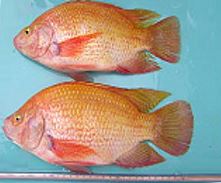 Red tilapia ( Oreochromis sp.)
Red tilapia ( Oreochromis sp.)
- Studies on the Artificial propagation of Japanese eel ( Anguilla japonica )
- Broodfish breeding.
- To establish appropriate models for the induced maturation of Japanese eels.
- To induce natural spawning after DHP injection.
- To increase the survival rates of hatching fry by different kinds of food, water environment, etc.
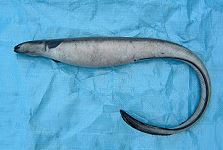 Female eel induced to maturation
Female eel induced to maturation
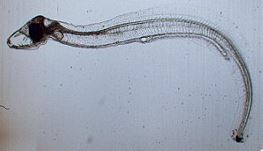 25-day-old eel fry
25-day-old eel fry
- Release of Japanese eel ( Anguilla japonica )
- According to the catadromous property, eel broodstock are released to the sea, to increase the elver resources.
- To study its reverine ecology, adult eels are released to the rivers.
- Tracking and sampling of the eels released to the rivers, to evaluate the efficacy.
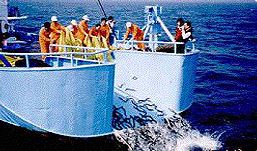 Eel broodstock released to the sea
Eel broodstock released to the sea
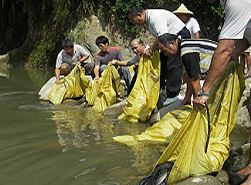 Adult eels released to river
Adult eels released to river
- Prevention of fish diseases by immunoactivators
- Immunoactivators (chitosan or glucan) as feed supplements are fed to fish, to check the elevation of cellular-immunity ability.
- To formulate efficacious doses of immunoactivators and implement the challenge test.
 Macrophages by cell culture
Macrophages by cell culture
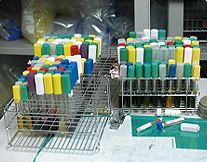 Microbiological bio-chemistry apparatus
Microbiological bio-chemistry apparatus
- Studies on the breeding techniques for endemic river fishes
- Natural population of some endemic river fishes are scarce, even on the edge of extinction, owing to overfishing, climate variety and exotic species intrusion.
- To study on the inhabitation environment of endemic river fishes, e. g. Zacco pachycephalus , Erythroculter ilisaeformis , Spinibarbus hollandi , Kuhlia rupestris , and to implement the physiological or ecological research.
- Establishment of the breeding techniques for endemic river fishes.
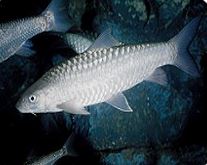 Spinibarbus hollandi
Spinibarbus hollandi
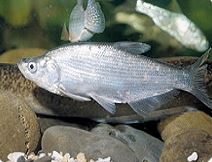 Topmouth culter ( Erythroculter ilisaeformis )
Topmouth culter ( Erythroculter ilisaeformis )
- Studies on the breeding techniques for new economic freshwater fishes
- Establishment of the breeding techniques for new endemic freshwater fishes with economic importance.
- Research of the breeding ways for exotic freshwater fishes.
- In search of the appropriate management models for the importation, research and extension of the exotic fishes.
- Some economic exotic fishes like Myxocyprinus asiaticus and 5 kinds of sturgeons have been imported and bred successfully.
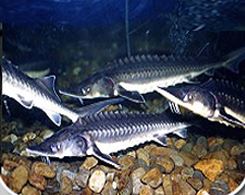 Amur sturgeon ( Acipenser schrenckii )
Amur sturgeon ( Acipenser schrenckii )
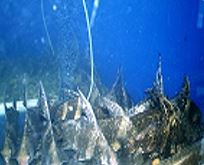 Chinese sucker ( Myxo- cyprinus asiaticus )
Chinese sucker ( Myxo- cyprinus asiaticus )
- Establishment of the genetic markers techniques for freshwater fishes
- Genetic markers of freshwater fishes are found out by the manipulation of DNA fingerprinting techniques, e.g. RAPD and microsatellite DNA, then to be the germplasm information.
 RAPD patterns of #211 primer on different populations of walking catfish ( Clarias focus )
RAPD patterns of #211 primer on different populations of walking catfish ( Clarias focus )
 RAPD patterns of #287 primer on different populations of walking catfish ( Clarias focus )
RAPD patterns of #287 primer on different populations of walking catfish ( Clarias focus )
- Development of Automated system for finfish seed production
- An automated system for egg collection, incubation, and transfer of fish larvae has been developed and applied successfully.
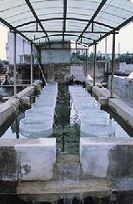 Automated system for fry production
Automated system for fry production
- Feed nutrition research for freshwater fishes
- Replacement of fish meal by plant protein to decrease the aquaculture cost.
- Addition of methionine, lysine or carnitine to plant protein sources, to complement the nutrition and to see its effect on the growth and flesh of silver perch and tilapia.
- To study the effect of bamboo charcoal or bamboo vinegar as feed additives on fish growth, fish flesh and cultural environment.
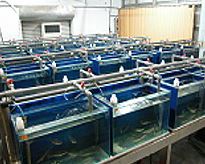 Apparatus for nutrition Research
Apparatus for nutrition Research
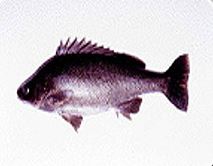 Silver perch ( Bidyanus bidyanus )
Silver perch ( Bidyanus bidyanus )
- Establishment of national germplasm bank of aquatic organisms-FARC branch
- Genetic conservation building, breeding and genetic building and conservation greenhouses are constructed.
- To conserve alive aquatic organisms and manipulate the genetic breeding research.
- Application of molecular biotechnology to help the work of species identification and analysis.
- To inherit local aquatic culture and elevate the quality of aquatic products.
 Genetic conservation building
Genetic conservation building
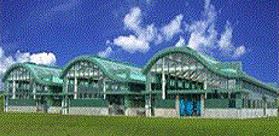 Conservation green-houses
Conservation green-houses
PROSPECT
- Establishment of the germplasm bank to converse freshwater species.
- Technological development of excellent fish species for freshwater aquaculture.
- Application of biotechnology on the aquaculture.
- Implementation of genetic breeding of tilapia.
- Establishing the technique of artificial propagation and larval rearing of Japanese eel.
- Studies on improving health and nutritional condition of cultured species.